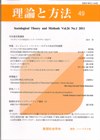Volume 22, Issue 2
Displaying 1-8 of 8 articles from this issue
- |<
- <
- 1
- >
- >|
Special Section
-
2007 Volume 22 Issue 2 Pages 137-138
Published: October 31, 2007
Released on J-STAGE: January 08, 2008
Download PDF (744K) -
2007 Volume 22 Issue 2 Pages 139-153
Published: October 31, 2007
Released on J-STAGE: January 08, 2008
Download PDF (985K) -
2007 Volume 22 Issue 2 Pages 155-168
Published: October 31, 2007
Released on J-STAGE: January 08, 2008
Download PDF (1059K) -
2007 Volume 22 Issue 2 Pages 169-187
Published: October 31, 2007
Released on J-STAGE: January 08, 2008
Download PDF (972K)
Articles
-
2007 Volume 22 Issue 2 Pages 189-203
Published: October 31, 2007
Released on J-STAGE: January 08, 2008
Download PDF (1087K) -
2007 Volume 22 Issue 2 Pages 205-225
Published: October 31, 2007
Released on J-STAGE: January 08, 2008
Download PDF (1111K)
Book Reviews Reply
-
2007 Volume 22 Issue 2 Pages 227-228
Published: October 31, 2007
Released on J-STAGE: January 08, 2008
Download PDF (773K)
Book Reviews
-
2007 Volume 22 Issue 2 Pages 229-239
Published: October 31, 2007
Released on J-STAGE: January 08, 2008
Download PDF (883K)
- |<
- <
- 1
- >
- >|
